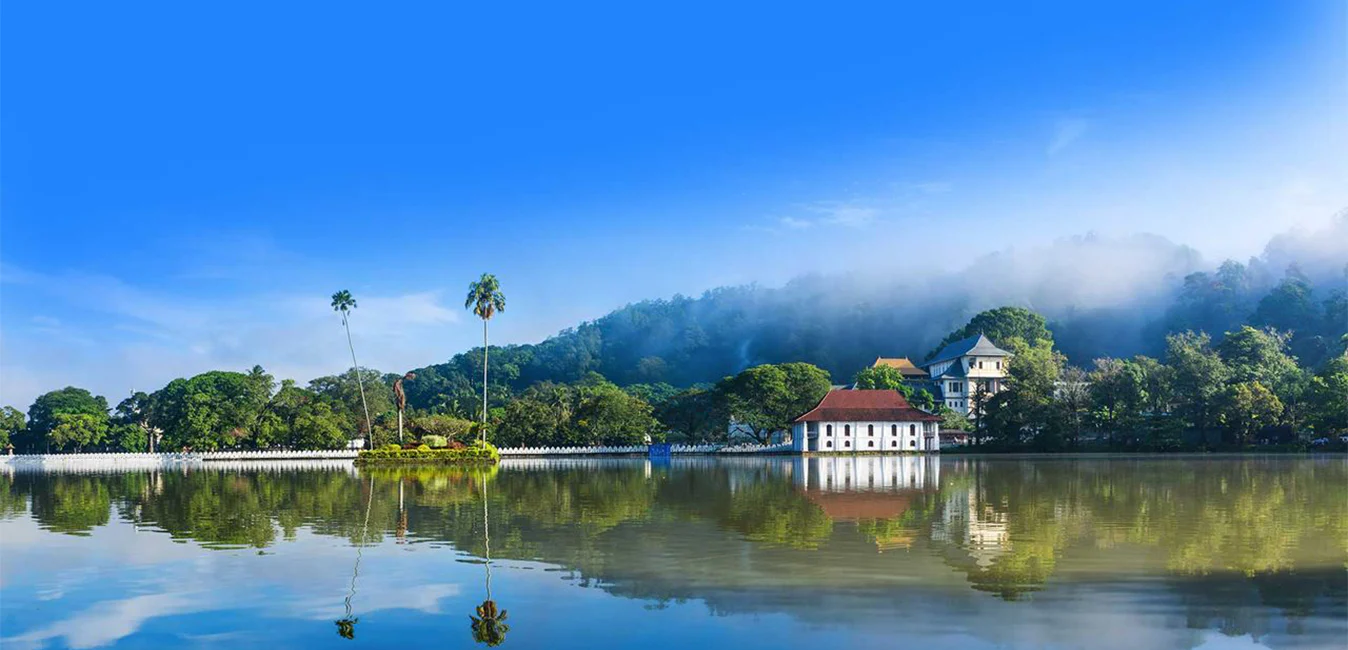
Kandy City
Kandy, a picturesque city in central Sri Lanka, is renowned for its rich cultural heritage, vibrant festivals, and scenic beauty. Nestled amidst lush hills, it is home to the Temple of the Tooth Relic, a UNESCO World Heritage Site, and offers a captivating blend of history and natural splendor.
Kandy
Kandy, the cultural capital of Sri Lanka, a World Heritage Site sits pretty in a valley surrounded by rings of mountains, 115km away from the seaport of Colombo. Right in the heart of the city center of Kandy is the man-made lake called Kiri Muhuda (Sinhala: the sea of milk), the one and only decorative lake in Sri Lanka. All other thousands of man-made reservoirs in Sri Lanka are developed primarily for the purposes of irrigation, and secondarily for the purposes of general use and wildlife conservation.
Built in the medieval era, the lovely lake is encircled by a short white-washed parapet called Valakulu Bamma (Sinhala: Embankment of clouds) with the pedestrian pavement and motor road running next to the parapet. In the center of the lake is an Island.
Southwestern corner of the lake makes way- a just a few steps - to the garden of the Temple of the Tooth. Udawattakele Bird Sanctuary with its densely wooded green hills looms over the red tile roofs and golden canopy of the Temple of the Tooth. Located within the courtyard of the Temple of Tooth are Tourist Office and Cultural Triangle Office.
Kandy is home to a multitude of medieval Buddhist temples. Great Kandy Esala Perahera Pageant, the yearly grand homage-rainmaker celebration in exposition of Tooth Relic of Buddha around the city is one great methodical riot of fire, light and sounds of fire play dancers, drummer dancers, dancers, drummers, piper dancers, pipers and caparisoned elephants.
Kandy is also featured on TripAdvisor, Viator and GetYourGuideAbout Kandy District
Kandy district is situated in the centrel province of Sri Lanka. One of the seven World Heritage Sites in Sri Lanka, Kandy was once home to the Kandyan Kings of yore in the 16th-century and a fountainhead for all the music, arts, crafts and culture in the country. About 129 km away from Colombo, Kandy is ensconced amongst a hilly terrain and all eyes are drawn to the centre of the city, where the Kandy Lake forms a charming feature. Kandy retains great religious significance for Sri Lanka, because it is in this charming city that the Dalada Maligawa or "Temple of the Tooth" is located, within which the sacred tooth relic of Lord Buddha lies well guarded.
The Royal Botanical Garden, Peradeniya is situated about 5 km to the west of the city centre at Peradeniya and is visited by 1.2 million people per year. It is the largest botanical garden on the island. The Udawatta Kele (Udawatta Forest) is a protected sanctuary situated in the heart of the city, just north of Temple of the Tooth.
Kandy is a Sinhala majority city; there are sizeable communities belonging to other ethnic groups, such as Moors and Tamils. Kandy is second only to Colombo the center of the Sri Lankan Economy. Many major co operations have large branch officers in Kandy and many industries include textiles, furniture, Information Technology and jewellery are found here. Many agriculture research centers are located in the city.
And a fountainhead for all the music, arts, crafts and culture in the country. About 129 km away from Colombo, Kandy is ensconced amongst a hilly terrain and all eyes are drawn to the centre of the city, where the Kandy Lake forms a charming feature. Kandy retains great religious significance for Sri Lanka , because it is in this charming city that the Dalada Maligawa or Temple of the Toothis located, within which the sacred tooth relic of Lord Buddha lies well guarded.
About Central Provincce
The Central Province of Sri Lanka consists primarily of mountainous terrain. The province has an area of 5,674 km², and a population of 2,421,148. Some major towns include Kandy, Gampola (24,730), Nuwara Eliya and Bandarawela. The population is a mixture of Sinhalese, Tamil and the Moors.
Both the hill capital Kandy and the city of Nuwara Eliya are located within the Central Province as well as Sri Pada. The province produces much of the famous Ceylon tea, planted by the British in the 1860s after a devastating disease killed all the coffee plantations in the province. Central Province attracts many tourists, with hill station towns such as Kandy, Gampola, Hatton and Nuwara Eliya. Temple tooth or Dalada maligawa is the main sacred place in Centrel province.
The climate is cool, and many areas about 1500 meters often have chilly nights. The western slopes are very wet, some places having almost 7000 mm of rain per year. The eastern slopes are parts of the mid-dry zone as it is receiving rain only from North-Eastern monsoon. The Temperatures range from 24°C at Kandy to just 16°C in Nuwara Eliya, which is located 1,889 m above sea level. The highest mountains in Sri Lanka are located in the Central Province. The terrain is mostly mountainous, with deep valleys cutting into it. The two main mountain regions are the central massif and the Knuckles range to the east of Kandy.























